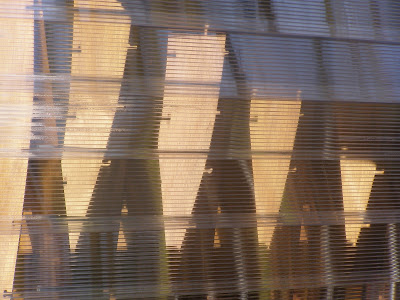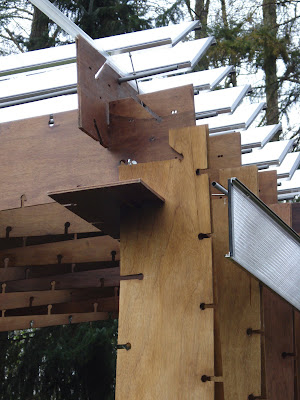Global Warming is one of the biggest challenges facing humanity yet politically correct sustainability is a symptom of a deeper underlying problem of resistance to change. Innovation is critical in our time, it requires continual open enquiry and rigorous testing to tackle the challenges on the planet. With such large scale challenges many still continue to follow tradition. For example the building industry which remains conservative, slow, and inefficient. The building industry requires a radical shift to address CO2 production, but more importantly it needs to open to fundamentally new forms of construction.
My strong belief is that mini-prototyping can be used as a strategic instrument to help unlock new ideas quickly. It is an effective and inexpensive method to test and implement low impact construction processes and products into the building industry. The yacht building industry provides a useful parallel, which has been successfully catalysed through a stream of radical innovations from mini-prototyping in competitions such as the ‘Mini-Transat’ which have significantly affected standard boat production. A similar low cost bottom-up approach for the building industry with ‘many starts’ could catalyse the industry towards new methods, approaches, materials and technologies to initiate openness to real innovation.
From traditional construction… To MINI-PROTOTYPE construction
- a limited few big companies to many SMALL (DoItYourself) builders
- expensive to CHEAP
- difficult to EASY
- hi-impact (heavy) to LOW IMPACT (light)
- energy dependent to ENERGY INDEPENDENT
- one off site specific to CLICKABLE COMPONENTS(site adaptable)
- fixed in place to RE-LOCATE-ABLE
- non-recycle to RE-CYCLE / RE-ASSEMBLE
- limited resources to RENEWABLE resources
- services dependent to SERVICES INTEGRATED
- structure + network to STRUCTURE IS THE 'electronic' NETWORK
- traditional shelter to SELF EDUCATIONAL ENABLING TOOL
Housing the humanity of the planet requires many different and varied solutions, however a dwelling system that can tap into natural resources and maximize their benefit for its occupants to provide essential needs very inexpensively could be a huge force for change.
MINIMAL LIVING
The essential needs for minimal dwelling now go well beyond the experiments of Henry Thoreau’s hut at Walden Pond. Today even a favela citizen must be digitally connected for survival. Shelter now includes ones ‘electronic being’ whether for off-shore sailor, mountaineer, favela citizen or student. With the rapid advance of alternative sources of energy such as solar power, it is now possible for renewable energy to be completely ambient. By this we mean the energy source can be fully integrated into the building structure and components.
Digital technology is seen as an integrated part of the structure – The structure is the electronic network or ‘dwelling as computer’. Thus a CLICK-RAFT could enable its inhabitants to operate and process energy, water, food and information. Such a dwelling becomes an enabling tool – skill enabling, education enabling, and income enabling. Just as the project for the $100 computer, a digital house would be equally useful, where the dwelling becomes an autonomous electronic live-work unit.
DESCRIPTION: “CLICK-RAFT” MICRO LIVE-WORK UNIT
The Goal is to realize a very cheap (under $10,000), easy to distribute (materials available globally), quick to assemble (max one day), low maintenance autonomous work-live unit. A new form of RAFT architecture which utilizes the structural qualities of plywood 'CLICK-LEAF' panels to form a network of structure made from standard panels which can be quickly assembled or ‘clicked’ together into RAFT's to form floors, walls, and roofs. The raft architecture weaves insulation, cladding, plumbing, energy, water systems, storage and furniture into the structural fabric of the building. The building touches the ground lightly. But the system's flexibility offers many open ended configurations which can be explored by the user/ builder to respond to site specific conditions. CLICK-RAFT's are perfectly suited for temporary, difficult or fragile ecological sites through the choice of materials, autonomous systems, mini-size, and click-able elements to minimize disturbance. But they can also be used as emergency shelters, backyard workspace or studio, mini-flat or rooftop extension and they can be networked or extended.
INNOVATION ASPECTS
• CLICK-RAFT component building system
• integrated Plastic Fullerene solar cell technology
• technique of assembly only requires one person to build +assemble.
• deliverable flat-pack 'LEAF' panels pre-cut from 2440x1220 plywood sheets
• CLICK-LEAF panel provides many fixing options for (dis) assembly
• autonomous clickable energy, water, and waste systems.
• lightweight, rapidly deployable (classifies as temporary dwelling).
• integrated clickable electronic and energy systems
• clickable component software to compliment the hardware system
HARDWARE MATERIALS:
• 2440x300 pre-cut plywood 'CLICK-LEAF' panels
• a range of external 'LEAF' cladding materials are being explored, eg insulated polycarbonate honeycomb sandwich, and thermal membranes.
• powered by thin film fullerene-based ‘plastic’ (ongoing developments allowing) solar cell technology.
• various insulation material options include warmcell cellulose fiber (recycled paper), sheepwool batts, hemp recycled cotton batts or hi-tech sandwich panel systems
• 12 volt ‘Eutrac’ electrical system for light, switch, micro-processor, & energy management systems integrated into the CLICK-BEAM components
• roof water re-cycled to integrated hydroponic and water storage systems
• organic toilet/ packet toilet systems being explored.
IMPLIMENTATION
The first CLICK-RAFT prototype is under development as an immediately realizable and fully test-able prototype. Construction includes first generation components which are intentionally rudimentary to get the project running with a minimal budget to the basic concept and systems.
The plan to implement the research project is based on developing the CLICK-RAFT to next level refinement of the panel components can be developed with fully integrated systems. All additional parties are development partners involved to develop next generation component research and development.
An important factor during the next stage will be to see how best to grow the product locally and globally. My feeling at this stage is that bottom up open-source seeding rather than large scale market branding will be more appropriate for a product of this kind as many will be self-built, and it will be more important to keep costs to a minimum budget. However strong PR will be necessary to raise consumer market awareness of the exceptional value, usefulness and quality of the product.
All initial investment costs in design development, materials and component research are privately funded. Additionally the first CLICK-RAFT prototype 01 is under construction with first generation components within a minimal budget. The realization of the project is funded personally, but additional organizations are providing support, advice and research + development resources to provide an important network to keep the project viable.
To take the concept development to the next stage will require research and development of a series of next generation components such as the panel development and solar technology. This work will require additional funding for design development, component, materials and systems research together with production methods/costs, market strategy and viability.
NEXT STAGE DEVELOPMENT AREAS
1.0 refinement and optimization of CLICK-LEAF panel system and production process,
2.0 design development and production research of lightweight skins or 'CLICK-LEAF' Louvre systems
3.0 integratation of (fullerene-based ‘plastic’) thin film PV technology with outer 'CLICK-LEAF' cladding system.
4.0 integration of energy, waste, water and hydroponic research and development
5.0 Cybernetic clickable systems software research to manage energy, waste, water and information management systems.
6.0 clickable market research, and PR strategy.
TEAM: -
Architect and Team Leader:
Chris Moller - Architect & Urbanist
responsible for research, design development and project management.
Fullerene Solar Panel Research
Professor Kees J.C. Hummelen:
Professor in Chemistry at the University of Groningen. The Netherlands. He is also CSO of the fullerene products company Solenne B.V. The last ten years, his research activities have been in fullerene chemistry and development of plastic photovoltaic (PV) technology. Currently he is world #3 cited PV author
.
Cybernetic Systems
Prof John Frazer:
Head of the School of Design at Queensland University of Technology (QUT) in Brisbane, Australia. and international research co-coordinator for the Gehry Technologies Digital Practice Ecosystem. Author and pioneer of ‘An Evolutionary Architecture’. Prof Frazer will develop clickable software to enable the building to manage energy, waste, water and information management systems.
SUPPORT
Christophe de Jongh - Developer + Entrepreneur
Managing Director of Vlasbloem Project Development with specialist knowledge in housing in both the private and public sectors. He is responsible for delivering 2 new mini-dwelling concepts to open market.
David Inden – Entrepreneur + Engineer
Indirectly connected to the project as joint founder of the City On A Roof Foundation which initiated development of a new platform to encourage rooftop mini-prototyping for the creative industries and innovation environments. Additionally David is also an enthusiastic professional observer being both engineer and entrepreneur.
Sascha Haselmeyer – Innovation Expert
As an innovation expert and consultant Sascha has been invited as a partner through his ‘Living-Labs’ network to be involved in the City On A Roof initiative. From this perspective he is interested in the development of the CLICK-RAFT in relation to appropriate architectural environments conducive to innovation.






















